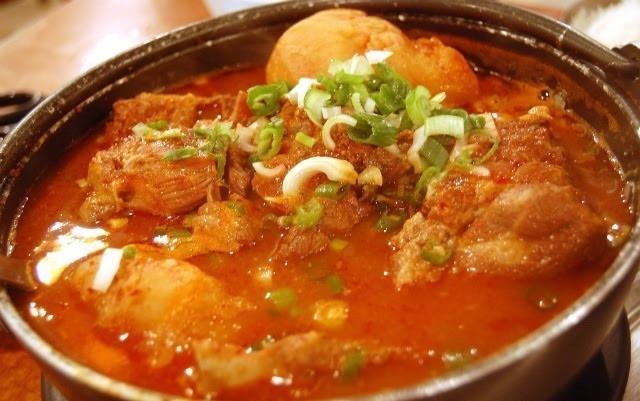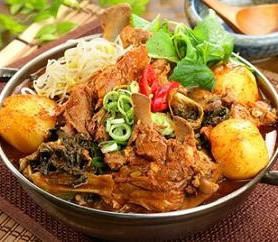Main ingredients Pork backbone | Type Tang | |
 | ||
Similar Haejang‑guk, Bossam, Seolleongtang, Jjim, Sundae | ||
Gamja-tang (감자탕) or pork back-bone stew is a spicy Korean soup made from the spine or neck bones of a pig. It often contains potatoes, cellophane noodles, dried radish greens, perilla leaves, green onions, hot peppers and ground sesame seeds.

The vertebrae are usually separated with bits of meat clinging to them. The vertebrae is boiled in high temperatures to soften the meat. To remove the meat, one must use an instrument such as a chopstick. The meal is usually served with kimchi and a bowl of rice. This food is served as a lunch or dinner and often as a late night snack as well.

The soup base is a deep red colour from the red hot peppers.
The soup is now common in Korean restaurants outside of Korea, including the United States and Canada.
History

Gamjatang originated in the southern Korean province of Jeolla. The main industry of Jeolla Province was agriculture, and hogs were widely raised and used for food. The origins of gamjatang can be traced back to the Three Kingdoms Era when South Jeolla farmers raised hogs in greater numbers than in most of the rest of Korea.
Since cows were the backbone of farming then, used both for their milk and plowing, cows were much more valuable than hogs. Slaughtering hogs for feasts and special occasions was much more common than slaughtering cows, which helps explain the dish's pork origins.
When Incheon harbor opened, many people migrated to Seoul and its surrounding area from Jeolla Province, as well as from other parts of the country. When construction of the Gyung-ui Railway began in 1899, lots of laborers started working around Incheon and gamjatang become popular among them because it is cheap, nutritious, and its high fat content provided the calories they needed. As time passed, gamjatang became one of the iconic foods of Incheon.
